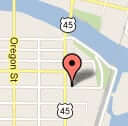9 Stats that Prove Electronics Recycling’s Human & Environmental Benefits
 9
9 Oct
The improper disposal of electronic waste is becoming a global epidemic. This fast-growing type of trash is ending up in the wrong places and posing risks to the environment and human health.
When Electronics Reach End-of-Life, Where Do They Go?
The International Telecommunications Union shared that only 20 percent of global e-waste is documented to be collected and properly recycled. Of the remaining 80 percent, 4 percent is thrown into residual waste and the fate of the remaining 76 percent is unknown – likely to be dumped, traded, or recycled under inferior conditions.

To shine light on the impact of e-recycling, we’ve compiled nine revelatory facts that prove the importance of working with a trusted, certified e-recycling partner.
Proper Electronics Recycling Makes a Difference
 The U.S. generated 3.4 million tons of e-waste in 2012. Of that, only 29.2 percent was recycled. The rest was tossed in landfills or incinerators (EPA).
The U.S. generated 3.4 million tons of e-waste in 2012. Of that, only 29.2 percent was recycled. The rest was tossed in landfills or incinerators (EPA).
 An estimated 30 to 40 million PCs will be ready for “end-of-life management” each year (EPA).
An estimated 30 to 40 million PCs will be ready for “end-of-life management” each year (EPA).
 E-waste affects nearly every system in the human body due to a plethora of toxic components including mercury, lead, cadmium, polybrominated flame retardants, barium, and lithium. These toxins can cause birth defects, brain, heart, liver, kidney, and skeletal system damage (Green Citizen).
E-waste affects nearly every system in the human body due to a plethora of toxic components including mercury, lead, cadmium, polybrominated flame retardants, barium, and lithium. These toxins can cause birth defects, brain, heart, liver, kidney, and skeletal system damage (Green Citizen).
 Informal recycling markets in China, India, Pakistan, Vietnam, and the Philippines handle anywhere from 50 to 80 percent of e-waste, and often shred, burn, and dismantle the products in “backyards.” Emissions from these recycling practices are damage human health and the environment (Population Reference Bureau).
Informal recycling markets in China, India, Pakistan, Vietnam, and the Philippines handle anywhere from 50 to 80 percent of e-waste, and often shred, burn, and dismantle the products in “backyards.” Emissions from these recycling practices are damage human health and the environment (Population Reference Bureau).
 According to BAN studies, 40 percent of tracked devices given to electronics recyclers in the U.S. were sent offshore instead of being recycled here (as the contracted recyclers claimed they would be).
According to BAN studies, 40 percent of tracked devices given to electronics recyclers in the U.S. were sent offshore instead of being recycled here (as the contracted recyclers claimed they would be).
 Fewer than 20 percent of cell phones are recycled each year, but if we recycled just a million cell phones, it would reduce greenhouse gas emissions equal to taking 1,368 cars off the road for a year (WasteCare).
Fewer than 20 percent of cell phones are recycled each year, but if we recycled just a million cell phones, it would reduce greenhouse gas emissions equal to taking 1,368 cars off the road for a year (WasteCare).
 For every 1 million cell phones recycled, 35,274 pounds of copper, 772 pounds of silver, 75 pounds of gold, and 33 pounds of palladium can be recovered (EPA).
For every 1 million cell phones recycled, 35,274 pounds of copper, 772 pounds of silver, 75 pounds of gold, and 33 pounds of palladium can be recovered (EPA).
 Recycling 1 million laptops can save the energy equivalent to the electricity used by 3,500 U.S. homes in a year, according to the EPA.
Recycling 1 million laptops can save the energy equivalent to the electricity used by 3,500 U.S. homes in a year, according to the EPA.
 One ton of circuit boards is estimated to contain 40-800 times more gold and 30 to 40 times more copper than one ton of mined ore (e-End USA).
One ton of circuit boards is estimated to contain 40-800 times more gold and 30 to 40 times more copper than one ton of mined ore (e-End USA).
A lot of good can come from proper e-recycling. Not only does safe e-recycling protect the environment, it safeguards communities by ensuring toxic fumes and materials aren’t released into the air or water sources – all while creating local job opportunities. Pledge to protect the environment by carefully vetting your e-recycler.
Not all e-waste recyclers are the same. Unfortunately, there are companies that export waste to developing countries. There are also e-recyclers that do not safely destroy the data on the device.
At Sadoff E-Recycling & Data Destruction, we use processing techniques that promote environmental stewardship and ensure 100 percent data destruction. We contractually own liability and are backed by insurance to give you peace of mind that your confidential information is kept secure. Look for certified e-recyclers that are trusted and known for their integrity and have certificates to back it up.

Ready to start responsibly e-recycling? Give us a call at (833) E-Recycl or message us online to get started today.
Tags: e-recycling, IT equipment, recycling IT equipment, sustainabilityCategorized in: E-Recycle, Electronics Recycling




 Google map directions
Google map directions
 Google map directions
Google map directions
 Google map directions
Google map directions
 Google map directions
Google map directions
 Google map directions
Google map directions
 Google map directions
Google map directions
 Google map directions
Google map directions